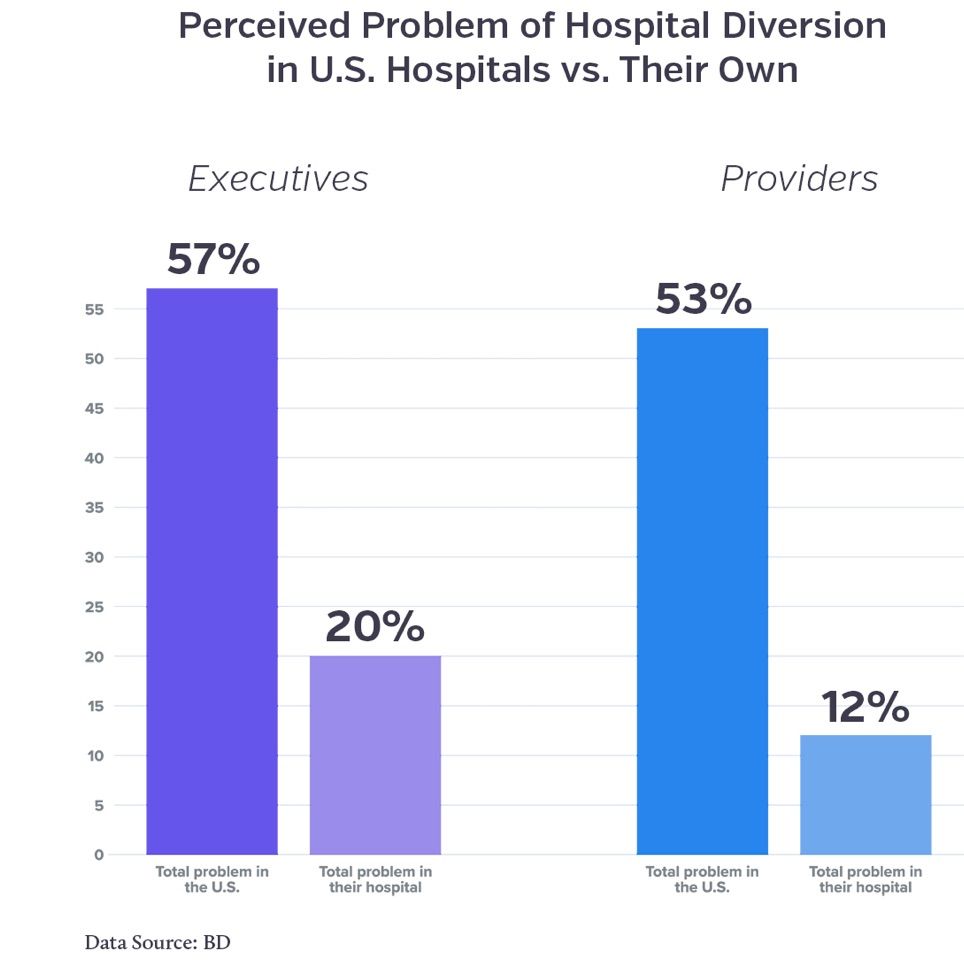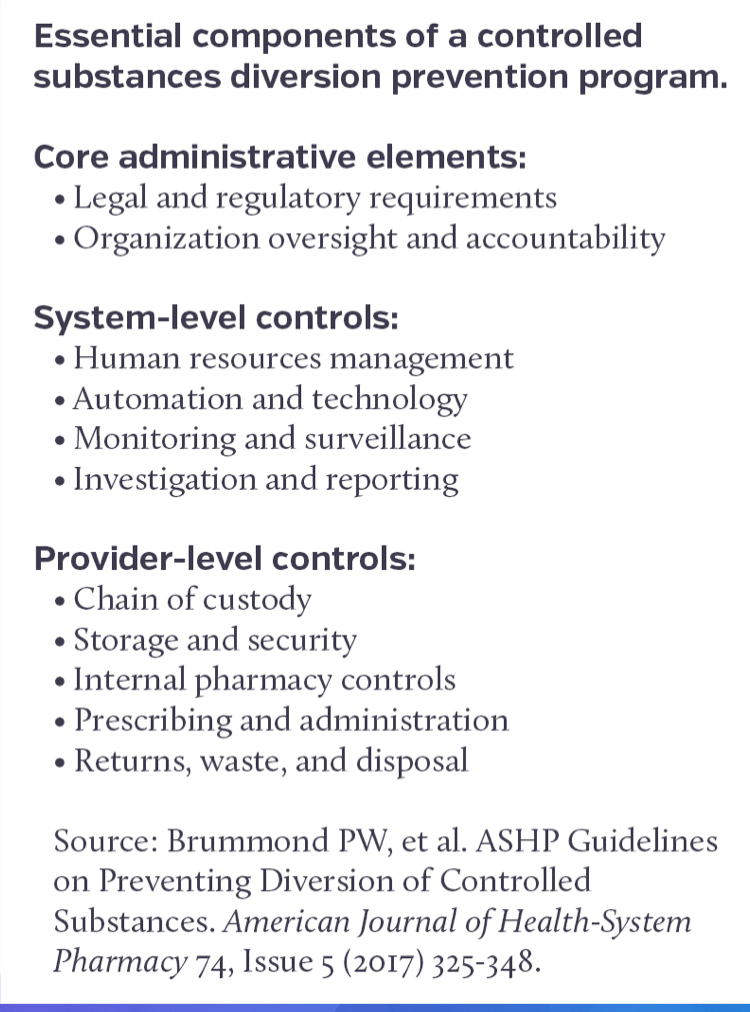Article
The Addiction Crisis in America’s Hospitals: Clinical Drug Diversion
Author(s):
Health care compliance analytics can be used to roll out institution-wide training and education programs to deter sloppy or nefarious behavior related to controlled substances.
No community has been spared the consequences of the overzealous marketing of opioid-analgesics that began in the late 1990s and triggered the ongoing addiction crisis. This crisis includes our health care workers, who face the same rates of addiction as other people, but also face risks and opportunities many do not.
Although alcohol is the drug of choice for the majority of health care workers who have substance use disorders (SUD), some turn to opioids, to which they have easy access in clinical settings. The consequences of such diversion are often devastating for the entire organization, especially their patients.
Clinical drug diversion is a criminal act. Worse, it jeopardizes patient safety and puts other staff at risk. Diversion can have significant legal and financial consequences for hospitals that do not identify, report, and prevent “diverters.” In 2018, hospital staff diverted $454 million worth of controlled substances, according to the Protenus Diversion Digest.
People who divert clinical drugs are unlikely to quit using them for the same reason as other people with addiction disorders: It is hard to do. They deny that they have a problem, they are ashamed, and they do not know where to turn for help.
In a hospital setting, they may (mistakenly) fear that seeking treatment will cost them their reputation and their career. According to some studies, coworkers and other staff members may know that a colleague has an addiction and is diverting clinical medications, but are reluctant to report them for fear of jeopardizing their livelihood.
Such silence reflects a misunderstanding of addiction itself, but also a failure to serve a primary mission: First, do no harm.
Acknowledge the Problem
For several years, some health systems viewed clinical drug diversion in the same way they once viewed privacy violations: It was happening, just not in their hospitals.

A recent survey from BD shows that hospitals now feel the same way about clinical drug diversion. However, in the past few years, as media coverage of the addiction crisis has exposed vulnerabilities in prescribing practices (eg, so-called “pill mills”), hospitals, and health systems have taken a tougher stance on clinical drug diversion and the cost it exacts on patients and their own bottom line.
Stories about the price patients have paid appear with alarming regularity in the media: A California anesthesiologist was found unconscious and half-naked near the operating room where he had spent years depriving patients of adequate anesthesia, leaving many to actually be aware of the procedures they were enduring; in Colorado, 19 patients contracted hepatitis C virus when an infected surgical tech used a needle that was then returned to a patient’s tray; and many more.
On top of this, hospitals do not want a media frenzy about poor practices. Nor do they want to find the DEA at their doors to question what has been going on and why it has gone undetected.
Turn to Technology: Recommendations From the Joint Commission and Professional Societies
In recent years, the Joint Commission and several professional societies (eg, The Hospice Foundation of America, the American Association of Nurse Anesthetists, the American Society of Health System Pharmacists, the Emergency Nurses Association, and others) have developed recommendations and policy guidelines on strategies for stopping clinical drug diversion while also offering treatment for their members who have addiction disorders. The Joint Commission lists essential components of such a program.

Health systems are addressing drug diversion with strategies that include much of what the Joint Commission recommends:
- education on substance misuse and addiction
- proper handling and disposal of medications
- changes to how certain medications are wasted
- more investigations, often manually based, of suspicious cases
Technology solutions have been incorporated as well, such as automated dispensing cabinets (ADCs). But even with these strategies, clinical drug diversion persists.
What is really needed is a cost-effective, efficient, preventive program that monitors every transaction (ie, dispensing, administration, wasting) of a controlled substance occurring within the hospital. Health care compliance analytics harness the power of artificial intelligence (AI) and machine learning with the expertise of subject matter experts, such as pharmacists and compliance teams, to detect and prevent clinical diversion.
Leverage AI and Health Care Compliance Analytics
Health systems generate millions of data points each month. It is impossible for any individual person, or even a team of people, to review all controlled substance transactions that occur throughout any hospital in a month or a year, looking for suspicious or anomalous events.
The level of staffing and resources required to do so would be prohibitive. Even with a comprehensive set of reports and the most diligent review team, few health systems could approach such a number.
With manual reviews, a certain number of alerts would be false positives as a result of documentation or practice errors. Each report would lead to a long list of events that could largely be explained or that were actually appropriate—leaving health systems to spend resources reviewing the noise rather than the signal.
Using AI, pharmacy or diversion teams can study a more complete picture of what is happening in their organizations. AI and compliance analytics integrate and make sense of data streams from many sources, such as ADCs, time and attendance systems, electronic health records, diagnosis, clinical events, and more.
Suspicious activity related to the use of the controlled substance will trigger a case, which describes what has happened and what makes it suspect. The appropriate team can then review the case and determine whether to launch an investigation, deciding in a few hours something that would once have taken weeks or finding activity that might have gone undetected for years.
Beyond detecting diversion, health care compliance analytics can provide the foundation for a robust and proactive drug diversion prevention program. These analytics review every controlled substance transaction across the organization, every single day.
Unlike manual reviews, which tend to lead to false positives, AI-powered analytics surface behavior trends that lead to real findings. At such an early juncture, diverters can be referred to appropriate treatment programs, while facing the consequences of their actions (ie, hospital policies and law enforcement).
Health care compliance analytics can also be used to roll out institution-wide training and education programs to deter sloppy or nefarious behavior.
Conclusion
AI is ideal for situations that involve confusion, scale, and repetition—such as the review of records, logs, and data. But to be used in situations that require complex decision-making, it must also be used by teams that understand the context in which it is being used.
Organizations such as the International Health Facility Diversion Association and National Association of Drug Diversion Investigators are great resources for information on how to leverage best practices and establish a diversion monitoring program to ensure the safety of the health care workforce and the patients under their care.





